You’ll preserve omega-3 fatty acids best by steaming fish at low temperatures, which maintains DHA and EPA integrity. Poaching in flavored liquids between 160-180°F creates protective barriers against oxidation. Baking in foil shields nutrients from direct heat, while low-temperature baking at 275-325°F prevents degradation. Quick sautéing with olive oil, gentle boiling below 150°C, and pan-steaming offer additional protection. Sous vide cooking provides precise control, microwaving at moderate power minimizes damage, and careful broiling preserves joint-supporting benefits. Master these techniques to release maximum nutritional potential.
Steaming Fish for Maximum DHA and EPA Retention

When you’re looking to maximize the omega-3 benefits from fish, steaming emerges as one of the most effective cooking methods for preserving DHA and EPA fatty acids.
Unlike frying or boiling, steaming doesn’t subject your fish to high heat or excessive water contact, which can degrade these vital nutrients.
You’ll retain more omega-3s by steaming for short periods at low temperatures. The moisture reduction actually concentrates these beneficial fatty acids while maintaining their best ratio.
Use a steaming basket or foil to minimize water contact and preserve nutrients within the fish.
This gentle cooking method outperforms baking and grilling for fatty acid preservation. Steaming also minimizes harmful chemical formation that can occur with high-temperature cooking methods.
You’re also maintaining essential minerals like calcium and iron while keeping calories low, making steamed fish an ideal choice for heart and brain health.
Baking in Foil to Shield Omega-3s From Heat Damage
When you wrap your omega-3 rich fish in foil before baking, you’re creating a protective shield that prevents direct heat exposure from damaging these sensitive fatty acids.
The foil acts as an insulation barrier, maintaining a controlled temperature environment that greatly reduces oxidation risks.
You’ll also benefit from enhanced moisture retention, which helps preserve the delicate fats while ensuring even cooking throughout your fish. This method is particularly effective since omega-3s remain stable at high heat when properly protected from direct exposure.
Foil Creates Protective Barrier
Three key factors make aluminum foil an excellent shield for protecting omega-3 fatty acids during cooking.
First, foil creates an enclosed environment that reduces your fish’s direct contact with oxygen, limiting oxidation of sensitive EPA and DHA.
Second, it minimizes exposure to high dry heat and air circulation that typically destroys these beneficial fats.
Third, the reflective surface distributes heat evenly, preventing localized overheating that accelerates omega-3 breakdown.
When you wrap fish in foil, you’re creating a protective barrier that blocks both oxygen and light—two primary causes of omega-3 degradation.
This sealed environment promotes gentle steaming from the fish’s natural juices rather than harsh dry heat exposure.
You’ll preserve considerably more omega-3s compared to frying, where fish faces simultaneous exposure to hot oil and oxygen. Adding a drizzle of olive oil provides additional protection to omega-3 fats during the cooking process.
Enhanced Moisture Retention Benefits
Beyond creating a protective barrier, foil baking delivers superior moisture retention that further guards your fish’s omega-3 content.
When you wrap fish in foil, you’re preventing moisture evaporation that would otherwise concentrate oxidative agents around delicate omega-3 fatty acids. This retained moisture maintains tissue hydration, reducing heat conduction rates and protecting EPA and DHA chains from thermal damage.
You’ll notice foil-baked fish stays tender because adequate moisture levels preserve the food’s natural texture while limiting omega-3 exposure to air.
This moisture control indirectly supports your joint health goals by maintaining higher omega-3 levels in your cooked meals. The hydrated cooking environment ensures your fish retains more anti-inflammatory compounds compared to dry-heat methods that accelerate fatty acid degradation. Additionally, lower temperatures reduce oxidation risk of omega-3s compared to high-heat cooking methods that can compromise their beneficial properties.
Gentle Boiling While Preserving Fatty Acid Integrity
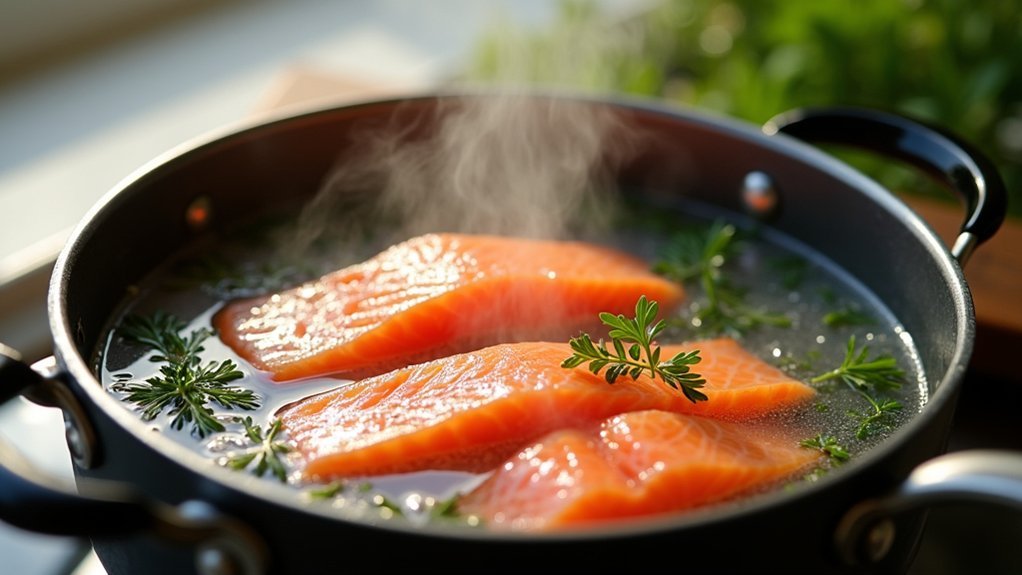
You’ll want to keep your water temperature at or just below 100°C when gently boiling omega-3-rich fish to minimize oxidative damage.
This controlled heat approach won’t break down EPA and DHA as aggressively as high-temperature cooking methods like frying.
Don’t forget to save that nutrient-rich cooking liquid, since some omega-3s will leach into the water during the boiling process. Natural antioxidants like vitamin C can help protect these delicate fatty acids from further degradation during cooking.
Optimal Temperature Control Methods
When you’re cooking omega-3 rich foods like eggs or fish, maintaining proper temperature control becomes essential for preserving these delicate fatty acids.
You’ll want to keep your cooking temperature below 150°C (302°F) to prevent significant degradation, as omega-3s begin oxidizing around 70-100°C but remain relatively stable at gentle boiling temperatures.
Here are four key temperature control methods:
- Start low and increase gradually – Preheat gently to avoid sudden heat shock to fatty acids
- Use a thermometer – Monitor temperatures to stay within safe ranges below 302°F
- Keep cooking times short – Remove food from heat immediately when done
- Cover while cooking – Use lids to minimize oxygen exposure and temperature fluctuations
Research shows that cooking actually increases the availability of MUFA and PUFA content in enriched foods while maintaining omega-3 levels when proper temperature control is applied.
These techniques guarantee you’ll maximize omega-3 retention.
Capturing Waterborne Omega-3s
While high-heat cooking methods destroy omega-3s through oxidation, gentle boiling creates a controlled environment that captures and preserves these valuable fatty acids in the cooking liquid.
You’ll retain more DHA and EPA by maintaining lower water temperatures and using sufficient water volume to dilute released fatty acids. Keep your cooking time short to minimize heat exposure, and maintain a neutral pH level in your cooking water for ideal nutrient stability.
When you’re gentle boiling fish, you’re fundamentally creating a protective barrier against oxidation while allowing the natural fatty acids to remain stable.
This method outperforms frying or high-heat sautéing, which cause significant omega-3 degradation. You can further enhance preservation by controlling moisture levels and selecting fish with naturally higher fat content for better retention rates. Since omega-3 fatty acids are essential fatty acids that must be obtained through diet, preserving their integrity during cooking becomes crucial for maintaining their health benefits.
Low-Temperature Baking for Consistent Nutrient Protection
Low-temperature baking stands out as one of the most reliable methods for preserving omega-3 fatty acids in fish while maintaining exceptional flavor.
You’re protecting EPA and DHA from oxidation while ensuring your fish retains its nutritional profile closest to its original state. This gentle cooking approach reduces inflammation-causing damage that high-heat methods typically create.
To maximize omega-3 retention during baking, you’ll want to follow these essential techniques:
- Maintain consistent oven temperatures between 275-325°F to prevent nutrient oxidation
- Wrap fish in foil to seal in moisture and protect delicate fatty acids
- Add olive oil to enhance nutrient absorption and prevent drying
- Monitor cooking time closely to avoid overcooking and excessive nutrient loss
You’ll preserve more heart-healthy and brain-supporting compounds compared to frying or other high-temperature methods.
Quick Sautéing With Antioxidant-Rich Olive Oil

Quick sautéing with antioxidant-rich olive oil offers another excellent approach for preserving omega-3 fatty acids while creating delicious, restaurant-quality fish dishes at home. You’ll want to heat olive oil over medium heat and cook your omega-3 rich fish quickly, typically 2-3 minutes per side. The antioxidants in olive oil protect delicate omega-3s from oxidative damage during cooking.
| Technique | Benefit |
|---|---|
| Add oil late in cooking | Minimizes heat exposure |
| Use medium heat | Prevents omega-3 breakdown |
| Cook 2-3 minutes per side | Preserves nutrient integrity |
| Choose sardines/anchovies | Maximizes omega-3 content |
This method’s effectiveness comes from olive oil’s natural stability when heated and its vitamin E content, which shields omega-3s from degradation while enhancing absorption. Be careful to avoid heating the oil to its smoking point, as overheated oils lose their nutritional value and can produce harmful compounds.
Sous Vide Cooking for Precise Temperature Control
When precision matters most in preserving omega-3 fatty acids, sous vide cooking delivers unmatched temperature control that protects these delicate nutrients from heat damage.
Sous vide’s precise temperature control safeguards delicate omega-3 fatty acids from destructive heat damage that compromises nutritional value.
You’ll maintain omega-3 integrity through gentle, low-temperature cooking that minimizes oxidative damage while preventing the nutrient loss common with high-heat methods.
This vacuum-sealed approach offers several advantages:
- Temperature precision – You’ll target exact internal temperatures without overcooking or undercooking.
- Moisture retention – Sealed bags prevent evaporation, keeping fish and proteins tender.
- Extended holding time – You can maintain perfect doneness for hours without quality loss.
- Consistent results – Eliminates guesswork while preserving sensitive omega-3s.
You’ll find this method particularly beneficial for lean fish prone to drying out, ensuring ideal nutrition retention. The flavor enhancement from this cooking technique seals in natural juices while infusing omega-3 rich foods with complementary herbs and spices for maximum taste and nutritional benefit.
Microwaving at Moderate Power for Rapid Preparation
Although microwave cooking gets criticized for potentially damaging nutrients, you’ll find that moderate power settings offer an effective compromise between speed and omega-3 preservation.
Use 500-600 watts for 5-15 minutes to minimize oxidation while maintaining convenience. You’ll retain omega-3s comparably well to boiling and grilling, with considerably less loss than frying or canning.
The key lies in controlling heating parameters. Higher power generates free radicals that accelerate omega-3 degradation, while moderate settings preserve these beneficial fats.
You’ll notice moisture loss creates firmer texture, but this actually protects remaining omega-3s during storage by limiting oxygen diffusion. When comparing processing methods, high-pressure processing demonstrates superior omega-3 retention over microwave techniques.
Though you’ll lose 20-30% of protective antioxidants like tocopherols, microwaving still outperforms traditional high-heat methods for omega-3 retention.
Poaching in Flavored Liquids Without Oil
You’ll find that poaching fish in flavored liquids protects omega-3 fatty acids through gentle heat that won’t break down these delicate nutrients.
This method lets you infuse rich flavors from wine, court bouillon, or fish fumet directly into your fish without adding any oil or fat.
You’re also preserving essential vitamins and minerals that might otherwise leach out during high-temperature cooking methods. Many people avoid poached fish because they think it’s bland, but using aromatic vegetables like garlic and onions transforms the dish into something far more flavorful.
Gentle Heat Protection
While high-heat cooking methods can destroy up to 70% of omega-3 fatty acids in fish, poaching offers a remarkably gentle alternative that preserves these essential nutrients. By maintaining temperatures between 160°F and 180°F, you’ll protect delicate EPA and DHA from breaking down while avoiding harmful compounds like PAHs and heterocyclic amines.
The gentle heat approach provides multiple advantages:
- Temperature Control – Keep water below 180°F to maximize omega-3 retention
- Oxidation Prevention – Liquid creates a protective barrier around fish tissue
- Anti-inflammatory Preservation – Maintains omega-3’s joint health benefits without degradation
- Even Cooking – Distributes heat uniformly, preventing nutrient hot spots
Studies consistently show that omega-3 fatty acids can help lower levels of inflammatory markers in the body, making proper cooking methods essential for joint health support.
This method guarantees your omega-3-rich fish retains its anti-inflammatory properties for ideal joint health support.
Flavor Infusion Benefits
Beyond temperature control, poaching transforms ordinary fish into a flavor powerhouse by using aromatic liquids that penetrate the flesh without adding unwanted fats.
You’ll discover that broth, wine, or mirin create rich flavor profiles while preserving those precious omega-3s your joints need.
Try adding thyme or rosemary to your poaching liquid for Mediterranean-inspired dishes, or experiment with soy sauce and mirin for Asian flavors. The herbs release essential oils that boost the health benefits of your meal.
White wine and lemon create light, citrusy notes that complement delicate fish perfectly. The gentle heat guarantees even flavor absorption throughout the flesh.
You’re getting maximum taste without compromising nutritional benefits. Each bite delivers both the anti-inflammatory omega-3s your joints crave and complex flavors that make healthy eating genuinely enjoyable.
Nutrient Retention Techniques
When you poach fish in oil-free flavored liquids, you’re employing one of the most effective methods for preserving delicate omega-3 fatty acids that support joint health. This gentle technique maintains EPA and DHA levels while preventing oxidation that destroys these beneficial fats.
Your poaching liquid becomes vital for nutrient retention:
- Use acidic components like mirin or vinegar to protect omega-3 structure by lowering pH
- Choose nutrient-rich broths with umami elements like miso to maintain moisture and density
- Control temperature at 70-80°C to preserve proteins and omega-3s without degradation
- Reuse poaching liquid as sauce to retain dissolved nutrients for maximum intake
You’ll avoid harmful oxidation products while maintaining the anti-inflammatory properties essential for joint support and cartilage health. This gentle simmering cooking method is widely celebrated in Mediterranean and Asian cuisines for its ability to retain the fish’s natural tenderness and moisture.
Broiling With Minimal Heat Exposure Time
Broiling offers an excellent middle ground for preserving omega-3 fatty acids when you control both temperature and timing.
You’ll retain more omega-3s by using lower broiling temperatures and shorter cooking times compared to high-heat methods like frying. Monitor your fish’s internal temperature carefully to avoid overexposure to heat, which breaks down these beneficial fats.
Flip your fish during broiling to guarantee even cooking while minimizing heat exposure. Marinate beforehand to retain moisture and potentially protect omega-3s. Using olive oil during broiling adds another layer of protection for these delicate nutrients.
While broiling won’t preserve omega-3s as effectively as poaching or steaming, it’s considerably better than frying.
This cooking method helps you maintain the anti-inflammatory benefits that support joint health. These essential fatty acids must be obtained through your diet since your body cannot produce them naturally.
Pan-Steaming With Covered Moisture Retention
Pan-steaming with covered moisture retention delivers superior omega-3 preservation by creating a gentle, humid cooking environment that protects these delicate fatty acids from oxidative damage.
You’ll maintain more EPA and DHA compared to high-heat methods like frying or baking, while the consistent temperature control prevents excessive nutrient breakdown.
Key advantages of pan-steaming for omega-3 retention:
- Temperature stays low – preventing omega-3 oxidation that occurs with direct heat exposure
- Moisture locks in nutrients – the covered environment retains natural fish oils and water-soluble vitamins
- Even heat distribution – guarantees consistent cooking without hot spots that damage delicate compounds
- Faster cooking time – reduces overall heat exposure compared to braising or slow-cooking methods
You’ll need only a covered pan and minimal water to create this nutrient-preserving cooking environment. Research shows that water-based cooking methods like pan-steaming preserve omega-3 fatty acids in fish better than high-temperature frying techniques.
Frequently Asked Questions
How Long Can Cooked Fish Retain Its Omega-3 Benefits When Stored?
You can store cooked fish for up to 3 days refrigerated or 2 weeks frozen while maintaining ideal omega-3 benefits. Proper packaging and low temperatures slow degradation considerably.
Do Omega-3 Supplements Provide the Same Joint Benefits as Properly Cooked Fish?
You’ll get consistent EPA and DHA doses from supplements, but you’re missing additional nutrients found in fish. Both provide joint benefits, though seafood often shows stronger overall health advantages in studies.
Which Fish Species Naturally Contain the Highest Concentrations of Joint-Supporting Omega-3s?
You’ll find mackerel leads with 4,580mg EPA+DHA per serving, followed by wild salmon, herring, and sardines at 2,150mg per 100g. Lake trout reaches 3,000mg, making these your top choices for joint support.
Can Frozen Fish Maintain Omega-3 Levels as Effectively as Fresh Fish?
You’ll find frozen fish maintains omega-3 levels just as effectively as fresh fish when it’s flash-frozen immediately after catch. Commercial freezing actually preserves nutrients better than improperly stored fresh fish.
What Signs Indicate That Fish Omega-3s Have Been Damaged During Cooking?
You’ll notice fish omega-3 damage through strong fishy odors, tough dry texture, excessive oil leaking, white overcooked appearance, and easy flaking. These signs indicate you’ve overcooked and degraded valuable nutrients.
In Summary
You’ve got powerful tools to maximize your omega-3 intake through smart cooking choices. By steaming, baking in foil, or poaching your fish, you’re protecting those precious DHA and EPA compounds that support joint health. Don’t let high heat destroy what nature provided—stick to gentle methods like low-temperature baking and quick sautéing. Your joints will thank you when you consistently apply these nutrient-preserving techniques to your daily meal preparation.

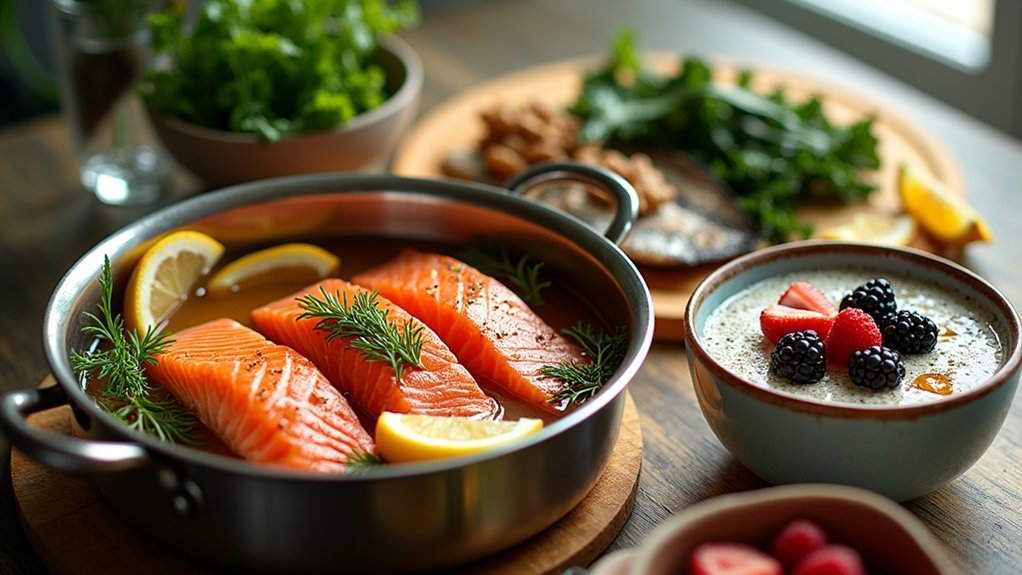
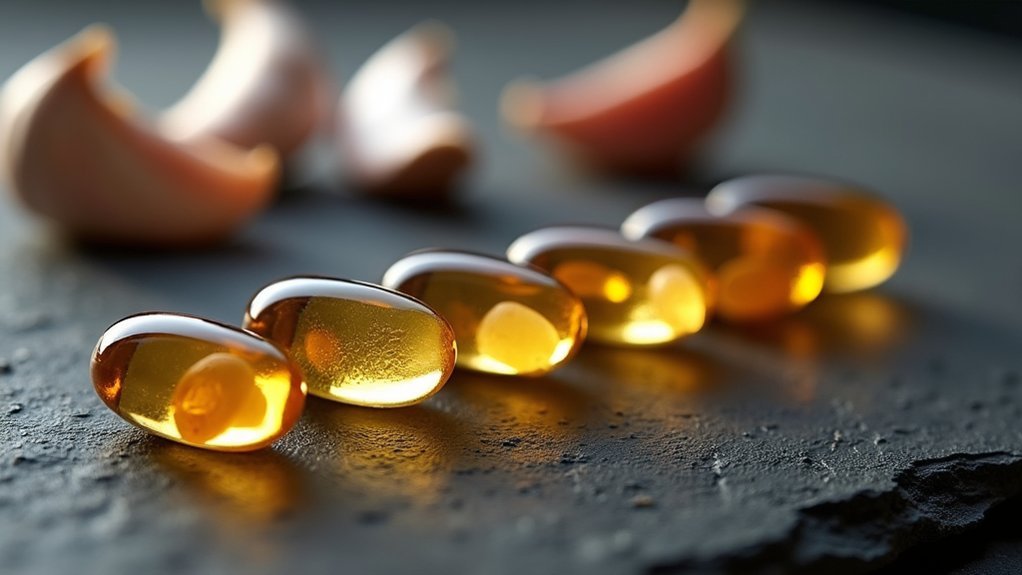
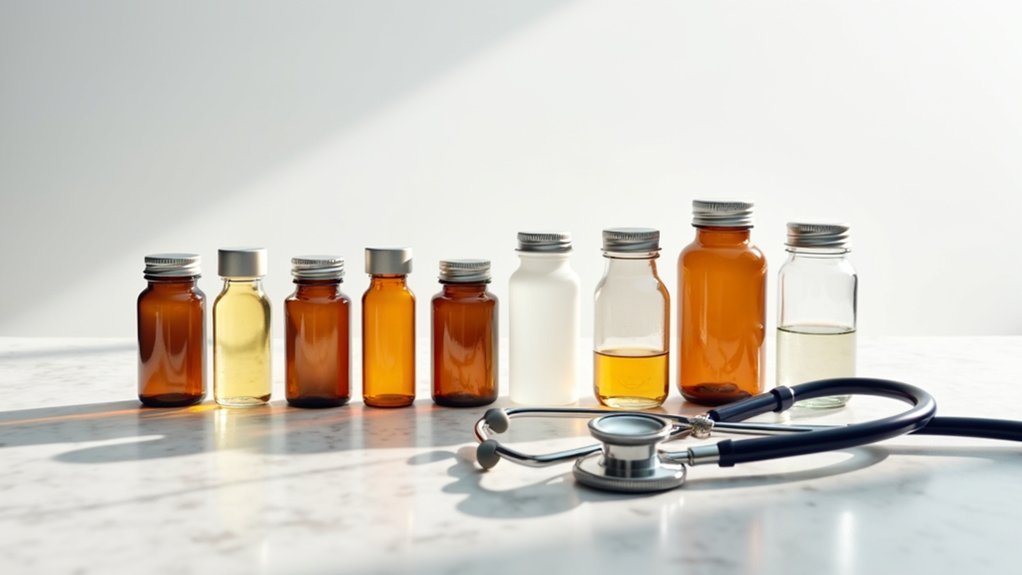
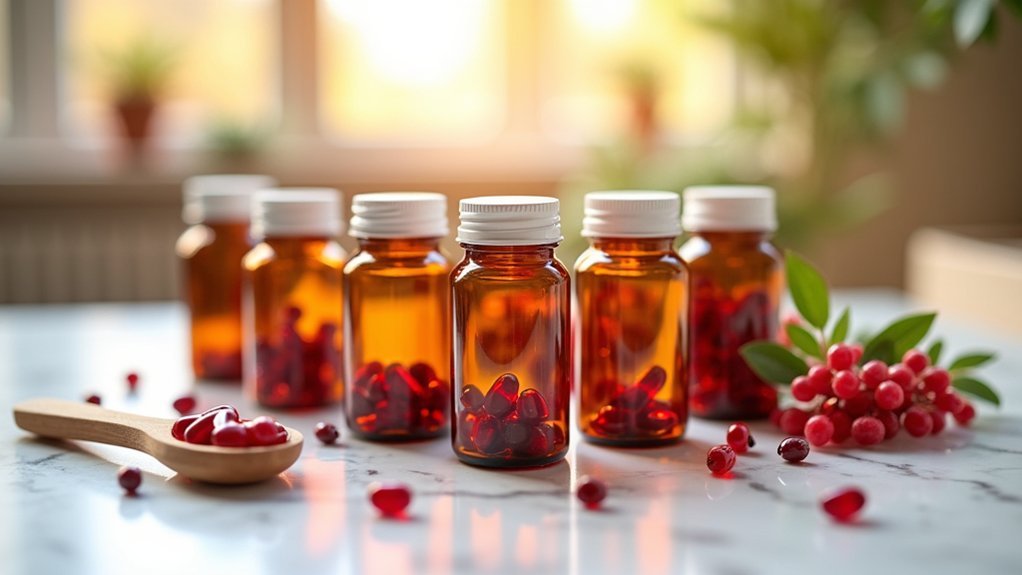
Leave a Reply